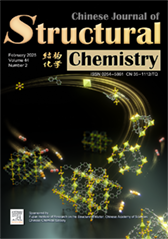
A new SIFSIX anion pillared cage MOF with crs topological structure for efficient C2H2/CO2 separation
Huirong Chen, Yingzhi He, Yan Han, Jianbo Hu, Jiantang Li, Yunjia Jiang, Basem Keshta, Lingyao Wang, Yuanbin Zhang* Submit a Manuscript
Limin Wang, Feiyi Huang, Xinyi Liang, Rajkumar Devasenathipathy, Xiaotian Liu, Qiulan Huang, Zhongyun Yang, Dujuan Huang, Xinglan Peng, Du-Hong Chen*, Youjun Fan*, Wei Chen*
Chin. J. Struct. Chem., 2025, 44(2), 100501. DOI: 10.1016/j.cjsc.2024.100501
February 1, 2025
Synchronous functionalization of graphene; Photoelectrochemistry; Confined spacing; Radical addition reaction; Water splitting and water desalination
ABSTRACT
Chemical functionalization of graphene is a topic of paramount importance to broaden its applications in chemistry, physics, and biological science but remains a great challenge due to its low chemical activity and poor dispersion. Here, we report a strategy for the photosynergetic electrochemical functionalization of graphene (EFG). By using chloride ion (Cl−) as the intercalation anions and co-reactants, the electrogenerated radicals confined in the expanded graphite layers enable efficient radical addition reaction, thus grasping crystalline-perfect EFG. We found that the ultraviolet irradiation and applied voltage have increased the surface/interface concentration of Cl•, thus boosting the functionalization of graphene. Theoretical calculation and experimental results verified the oxygen evolution reaction (OER) on EFG has been improved by regulating the doping of chlorine atoms. In addition, the reduced interlayer distance and enhanced electrostatic repulsion near the basal plane endow the fabricated EFG-based membrane with high salt retention. This work highlights a method for the in situ functionalization of graphene and the subsequent applications in OER and water desalination.






